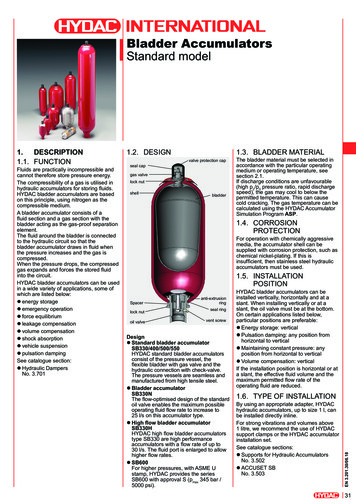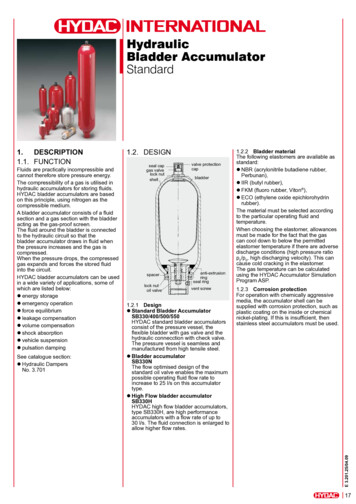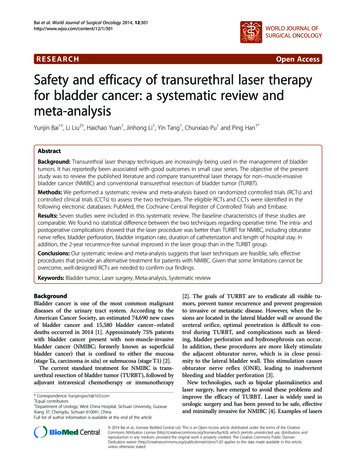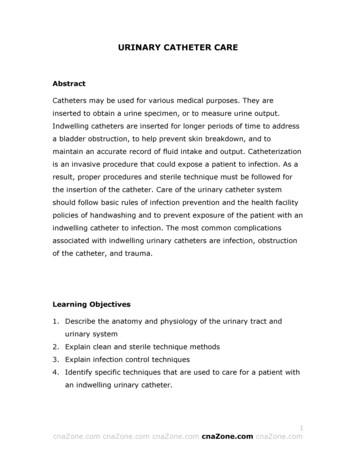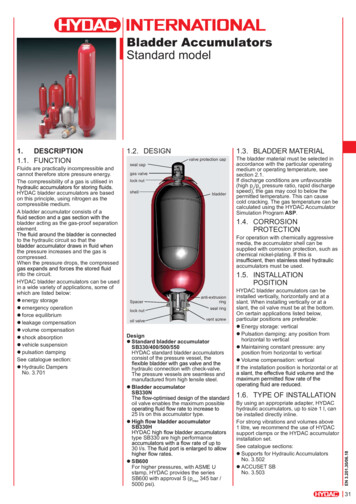
Transcription
(2021) 21:93Zachariou et al. BMC pen AccessCASE REPORTTransvaginal closure of urinary bladderopening and Mitrofanoff techniquein a neurologically impaired female with chronicindwelling catheter: a case presentationAthanasios Zachariou1,6* , Minas Paschopoulos2, Aris Kaltsas1, Fotios Dimitriadis3, Athanasios Zikopoulos1,Charalampos Mamoulakis4, Atsushi Takenaka5 and Nikolaos Sofikitis1AbstractBackground: Chronic catheterization remains the only attractive option in specific circumstances, especially in neurologically impaired patients. Complications produced by the indwelling catheters, like patulous urethra and bladderneck destruction, usually lead to severe incontinence and significant nursing difficulties. Here, we describe a rare case,a urinary bladder opening representing massive and extensive destruction of the urethra and bladder sphincter dueto an indwelling catheter.Case presentation: We present a 46-year-old paraplegic woman complaining of recurrent febrile urinary tract infections and severe urinary incontinence. She suffered from persistent malodorous urine and skin breakdowns from constant urine leakage. The vaginal examination revealed extensive destruction of the urethra and a 10 cm opening permitting the urinary bladder wall to prolapse into the vagina. The patient underwent a combined surgical approach; atransvaginal bladder closure with anterior colporrhaphy and a Mitrofanoff procedure to ensure a continent stoma forfuture clean intermittent self-catheterization (CISC). The patient is compliant with CISC and, remains continent twelveyears after surgery.Conclusion: This case demonstrates that in the era of CISC, there are still neurologically impaired females suffering from rare but critical adverse effects of indwelling catheters. The urethra and bladder neck erosion represent ademanding treatment assignment. The Mitrofanoff procedure for continent stoma and the transvaginal closure ofurinary bladder opening produced a lifesaving potential treatment.Keywords: Urethral damage, Indwelling catheter, Transvaginal urethral closure, Mitrofanoff, Case reportBackgroundClean intermittent self-catheterization (CISC) hasbecome generally accepted during the last decades asthe gold standard for the management of neurogenic*Correspondence: zahariou@otenet.gr1Urology Department, Medical School, University of Ioannina, Ioannina,GreeceFull list of author information is available at the end of the articlebladder. The principles of CISC are to empty the bladderefficiently, to avoid complications and to improve storage function [1]. The main reason for the institution of anindwelling catheter is the challenge in controlling urinaryincontinence in female patients. Chronic catheterizationremains an attractive option only in specific conditions.These are the impaired upper limb function in high cervical spine injury patients, the absence of a caregiver toperform clean intermittent catheterization and the lack The Author(s) 2021, corrected publication 2022. Open Access This article is licensed under a Creative Commons Attribution 4.0International License, which permits use, sharing, adaptation, distribution and reproduction in any medium or format, as long as yougive appropriate credit to the original author(s) and the source, provide a link to the Creative Commons licence, and indicate if changeswere made. The images or other third party material in this article are included in the article’s Creative Commons licence, unless indicatedotherwise in a credit line to the material. If material is not included in the article’s Creative Commons licence and your intended use is notpermitted by statutory regulation or exceeds the permitted use, you will need to obtain permission directly from the copyright holder. Toview a copy of this licence, visit http:// creat iveco mmons. org/ licen ses/ by/4. 0/. The Creative Commons Public Domain Dedication waiver(http:// creat iveco mmons. org/ publi cdoma in/ zero/1. 0/) applies to the data made available in this article, unless otherwise stated in acredit line to the data.
Zachariou et al. BMC Urology(2021) 21:93of satisfactory external collection device in the females[2].There are several reports in the literature describingthe complications of long term indwelling catheterization. These include bladder and peritoneal perforation[3], urinary infections [4], bladder calculi and catheterencrustations [5], catheter complications like blockage[6], urethral stenosis, urethral damage and malignancyassociated with chronic infection [7]. In a multicentercohort study of 2076 adults with an indwelling urethralcatheter, 57% of patients reported at least 1 complicationbecause of the catheter, and noninfectious complications(55%) were 5 times as common as infectious complications (11%) [8].One of the most challenging problems in the management of women with neurogenic bladders is incontinencearound their indwelling catheter. Anticholinergics, β3adrenoceptor agonist and a larger catheter, resolve urinary leakage for a limited time. The use of larger calibercatheters, can produce patients facing acute adverseeffects [9]. For example, pressure necrosis from longterm indwelling catheters and extrusion of a Foley catheter during sudden movements damage the urethra.Complications produced by the catheters, like patulous urethra and bladder neck destruction, usually leadto significant nursing difficulties. Severe incontinenceincreases the depression of these patients, who are oftenbedridden or wheelchair-bound and may also be suffering from coexisting pressure sores.In the present study, a rare case is described; a urinarybladder opening representing massive and extensivedestruction of the urethra and bladder sphincter due toindwelling catheter in a neurologically impaired woman.The combined use of two surgical approaches, the transvaginal closure of bladder opening and the Mitrofanofftechnique, produced a urinary bladder with a continentstoma. Furthermore, the reason to publish our case nowwas that there is a long term evaluation of the proposedtherapy since more than a decade has passed since theprocedures. Finally, emphasis should be given to thefact that in the era of CISC, there are still unusual critical complications concerning indwelling catheters anda combination of rehabilitation surgical techniques arealways crucial for radical treatment.Case presentationA 46-year-old paraplegic woman presented to the outpatient urology department, complaining of recurrentfebrile urinary tract infections and severe urinary incontinence for 2 years. She suffered from persistent malodorous urine and skin breakdowns from constant urineleakage. She typically used long-term urethral catheters,Page 2 of 5Fig. 1 The vaginal examination revealed destruction of the urethraFig. 2 The vaginal examination revealed a 10 cm opening permittingthe urinary bladder wall to prolapse into the vaginawhich had resulted in dilatation and pressure necrosis ofthe urethra with subsequent severe incontinence.The vaginal examination revealed destruction of theurethra and a 10 cm opening permitting the urinary bladder wall to prolapse into the vagina (Figs. 1, 2). Threefingers could be easily inserted into the urethra, and thebladder wall could practically be observed from the outside. A diffuse scar tissue area had replaced bladder trigone, and ureteral orifices were visible through the bladderopening. An intravenous urography was performed tocheck the anatomy of the upper urinary tract, which waswithin normal limits. The computed tomography (CT)scan did not assist in the diagnosis because of the artifacts caused by the bilateral total hip replacements.The patient underwent a combined transvaginalurethral closure with anterior colporrhaphy and a
Zachariou et al. BMC Urology(2021) 21:93Mitrofanoff procedure to ensure a continent stoma forfuture CISC. The patient was placed initially in the dorsal lithotomy position, and a retractor was placed inthe vagina. The labia were retracted laterally with staysutures. The damaged bladder wall was circumcised,and an anterior vaginal flap was raised. Special carewas taken to entirely free the lateral part of the bladder base and the attachments of the pubic bone. Therewas extensive destruction of pubourethral ligaments,and that allowed a complete mobilization of the bladderwall from the symphysis pubis. The opening was closedwith a 2/0 polyglactin (Vicryl ) suture. A second layer,using the same suture, was applied to invaginate furtherthe bladder opening to ensure an excellent postoperative result. An anterior colporrhaphy was accomplishedto push anteriorly further the bladder (third layer).Finally, the anterior vaginal flap was advanced to coverthe area where the previous urethra and bladder neckwere present, forming the last (fourth) layer of closure.A laparotomy followed immediately after that, and anappendicectomy was done, maintaining its blood supply. The tip of the appendix was transected, and a catheter was introduced to ensure patency. A Mitrofanoffprocedure was performed, and the appendix broughtout through umbilicus. A small cystostomy was made,and the bladder mucosa was prepared to accomplish anappendico-vesical anastomosis. Recovery from this procedure took six weeks. Initially, the Mitrofanoff channel was not used for draining urine. During this time,a suprapubic catheter was inserted to drain urine. Thesuprapubic catheter was removed once CISC throughthe Mitrofanoff channel started. The suprapubic catheteropening closed easily.During the initial postoperative period, the patientreceived oxybutynin for three months. The patient iscompliant with CISC and remains continent twelve yearsafter surgery. She has a normal renal function with noupper tract dilatation on ultrasonography. The womanunderwent evaluation recently, and she is still dry withno urinary fistula reported (Fig. 3).The patient reported complications concerning recurrent urinary tract infections and urine leakage whendelays the emptying. She performs four CISC per day andundergoes annual evaluation with an ultrasound examination to ensure that any stones that may have formedare removed.Discussion and conclusionLong- term urethral catheters in neurologically impairedfemale patients result in dilatation of the urethra andsevere incontinence. Patients presenting urine leakageare usually treated with a larger catheter, anticholinergics and/or β3 adrenoceptor agonists. ConventionalPage 3 of 5Fig. 3 The Mitrofanoff continent stomamanagement of this condition has been urethral closure(abdominal or vaginal) and the simultaneous placementof a suprapubic catheter. Postoperative detrusor spasmsrepresent a significant concern because they could probably increase the rate of fistula formation and postoperative incontinence. During the initial postoperative period,it is critical to continue the treatment with anticholinergics and/or β3 adrenoceptor agonists [10, 11]. The transvaginal closure of urethra and anterior colporrhaphyensure low morbidity and high success rates. The complete mobilization of bladder opening prevents high ratesof a postoperative urinary fistula. At long-term follow-upof this procedure, 50% of the women were dry after theinitial operation. Other complications encountered werebladder stones (21%), leakage around the catheter (17%),recurrent catheter blockage (10%), and urinary tractinfections [11].The functional urethral closure with pubovaginal sling[12], tension-free vaginal tape (TVT) [13], or a modifiedendoscopic colposuspension where sutures are tied moreclosely than for patients with genuine stress incontinence[14], represent alternative proposals. Careful patientselection for the aforementioned surgical methods is necessary because females with a completely eroded bladder neck and proximal urethra are not candidates for thisprocedure. They represent pilot studies with small number of patients and success rates up to 70%.Because patients with advanced neurological conditions are at high surgical risk, the transvaginal approachmay be the ideal option. It provides a good exposure,excellent tolerance and low morbidity. It can performin obese patients and the very unfit disabled patients
Zachariou et al. BMC Urology(2021) 21:93even under local anaesthetic. However, there are veryfew reports about the optimal treatment of a large bladder opening in female patients who are neurologicallyimpaired.For patients who do not desire or are unable to perform regular intermittent catheterization, the optionsinclude bladder neck closure done in conjunction withileovesicostomy or construction of an ileal conduit. Themain reason for choosing a conduit over ileovesicostomy is determined by the stoma site. Patients who usea wheelchair benefit from a stoma in a higher positionon the abdominal wall and this may be difficult to reachfor an ileovesicostomy [15].Umbilical location is an ideal position for cosmeticreasons, especially for patients willing to performCISC. Mitrofanoff appendicovesicostomy representsa convenient way to construct a continent abdominal,urinary stoma [16]. The advantages of appendix diversion include maintaining complete continence, easycatheterization; excellent body image; and rarity ofpost-surgical complications such as dermatitis and urinary tract infection. Regarding the length of appendix,the cutaneous stoma can be placed in the umbilicus orthe lower right abdominal quadrant [17, 18]. The submucosal tunnel and abdominal wall muscles are critical factors concerning the success rate of continenceaccording to Yang et al. [19].Continent catheterizable stomas display high rates ofcomplications, including stomal stenosis requiring revision or conversion to an alternative channel (12–30% ofcases). Usually, an ileal conduit is the alternative stoma,but a stomal appliance is a significant drawback forresource-deprived families [20].We performed an anterior colporrhaphy to ensure thetransposition of the bladder gap to a new position, highbehind the symphysis pubis. The multiple layers andthe special care for the underlying layers without apposition of the suture lines diminish the rates of fistula.We used the Mitrofanoff technique, usually presentedin children, to create a continent catheterizable stomaas an adjunct to continent urinary tract reconstruction.This case demonstrates that in the era of CISC, thereare still neurologically impaired females suffering fromrare but critical adverse effects of indwelling catheters. The urethra and bladder neck erosion representa demanding treatment assignment. The combined useof two surgical approaches (Mitrofanoff technique forcontinent stoma and transvaginal closure of urethrawith anterior colporrhaphy) represent rare but lifesaving potential treatment.Page 4 of 5AbbreviationsCISC: Clean intermittent self-catheterization; CT: Computed tomography; TVT:Tension-free vaginal tape.AcknowledgementsNot applicable.Authors’ contributionsAZ drafted the manuscript and reviewed the literature. AZ, FD, AK, CMhelped with the draft. AT, NS, MP revised the manuscript. All authors read andapproved the final manuscript.FundingNo funding was received for the creation of this manuscript.Availability of data and materialsData are available from the corresponding author on reasonable request.DeclarationsEthics approval and consent to participateWritten informed consent to participate was obtained from the patient of thiscase report. A copy of the written consent is available for review by the Editorin-Chief of this journal.Consent for publicationWritten informed consent was obtained from the patient for publication ofthis case report and any accompanying images. A copy of the written consentis available for review by the Editor-in-Chief of this journal.Competing interestsThe authors declare that they have no competing interests.Author details1Urology Department, Medical School, University of Ioannina, Ioannina,Greece. 2 Department of Obstetrics and Gynaecology, Medical School, University of Ioannina, Ioannina, Greece. 3 Urology Department, Medical School,Aristotle University of Thessaloniki, Thessaloniki, Greece. 4 Urology Department,Medical School, University of Crete, Heraklion, Greece. 5 Urology Department,Medical School, Tottori University, Yonago, Japan. 6 3 Spyridi Street, 38221 14Volos, Greece.Received: 15 December 2020 Accepted: 14 June 2021References s1. Shamout S, Biardeau X, Corcos J, et al. Outcome comparison of differentapproaches to self-intermittent catheterization in neurogenic patients: asystematic review. Spinal Cord. 2017;55:629–43.2. Andrews HO, Shah PJR. Surgical management of urethral damage inneurologically impaired femal patients with chronic indwelling catheters.Br J Urol. 1998;82:820–4.3. Zachariou A, Kolynou A, Filiponi M. Rectal perforation: a rare complicationof indwelling urethral catheterization. Hippokratia. 2017;21:58.4. Murphy C, Cowan A, Moore K, et al. Managing long term indwellingurinary catheters. BMJ. 2018;363:3711.5. Norsworthy A, Pearson M. From catheter to kidney stone: the uropathogenic lifestyle of Proteus mirabilis. Trends Microbiol. 2017;4:304–15.6. Milo S, Nzakizwanayo J, Hathaway H, et al. Emerging medical and engineering strategies for the prevention of long-term indwelling catheterblockage. Proc Inst Mech Eng [H]. 2018;1:68–83.7. Gui-Zhong L, Li-Bo M. Bladder cancer in individuals with spinal cordinjuries: a meta-analysis. Spinal Cord. 2017;55:341–5.8. Saint S, Trautner BW, Fowler KE, Colozzi J, Ratz D, Lescinskas E, Hollingsworth JM, Krein S. A multicenter study of patient-reported infectiousand noninfectious complications associated with indwelling urethralcatheters. JAMA. 2018;178(8):1078–85.
Zachariou et al. BMC Urology9.10.11.12.13.14.15.16.17.18.19.20.(2021) 21:93Page 5 of 5Linsenmeyer TA. Catheter-associated urinary tract infections in personswith neurogenic bladders. J Spinal Cord Med. 2018;41(2):132–41.Zimmern P, Hadley R, Leach G, Raz S. Tranvaginal closure of the bladderneck and placement of a suprapubic catheter for destroyed urethra afterlong-term indwelling catheterization. J Urol. 1985;134:554–6.Kubai U, Arunkalaivanan S, Baptiste M. Transvaginal closure of urethra andcorrection of uterovaginal prolapse in neurologically impaired patientwith chronic indwelling catheter. Int Urogynecol J. 2009;20:991–3.Chancellor M, Erhard M, Kiilholma P, Karasick S, Rivas D. Functionalurethral closure with pubovaginal sling for destroyed female urethra afterlong-term urethral catheterization. Adult Urology. 1994;43:499–505.Poddar A, Jackson S. Intentional urethral closure with a TVT (tension-freevaginal tape) for intractable urinary incontinence: a preliminary report ofthree cases. Int Urogynecol J Pelvic Floor Dysfunct. 2007;18:195–7.Wedderburn AW, Adamson AS. Management of the incompetent urethrain the chronically debilitated female patient: an alternative to urethralclosure. BJU Int. 1999;84:727–8.Ginsberg D. Management of the neurogenic bladder in the femalepatient. Curr Bladder Dysfunct Rep. 2006;1:65–70.Cain MP, Casale AJ, King SJ, Ring RC. Appendicovesicostomy and neweralternatives for the Mitrofanoff procedure: results in the last 100 patientsat Riley Children’s Hospital. J Urol. 1999;1999(162):1749.Abedi AR, Ghiasy S, Fallah-karkan M, Hojjati SA, Hosseini J. Appendicovesicostomy as an alternative procedure for patients with complex urethraldistraction defect. Urol J. 2020;17(4):386–90.Hakenberg OW, Ebermayer J, Manseck A, Wirth MP. Application of theMitrofanoff principle for intermittent self-catheterization in quadriplegicpatients. Urology. 2001;58:38–42.Yang W-H. Yang needle tunneling technique in creating antireflux andcontinent mechanisms. J Urol. 1993;150:830–4.Liard A, Seguier-Lipszyc E, Mathiot A, Mitrofanoff P. The Mitrofanoff procedure: 20 years later. J Urol. 2001;165:2394–8.Publisher’s NoteSpringer Nature remains neutral with regard to jurisdictional claims in published maps and institutional affiliations.Ready to submit your research ? Choose BMC and benefit from: fast, convenient online submission thorough peer review by experienced researchers in your field rapid publication on acceptance support for research data, including large and complex data types gold Open Access which fosters wider collaboration and increased citations maximum visibility for your research: over 100M website views per yearAt BMC, research is always in progress.Learn more biomedcentral.com/submissions
a suprapubic catheter was inserted to drain urine. e suprapubic catheter was removed once CISC through the Mitrofano channel started. e suprapubic catheter opening closed easily. During the initial postoperative period, the patient received oxybutynin for three months. e patient is compliant with CISC and remains continent twelve years

